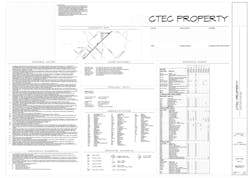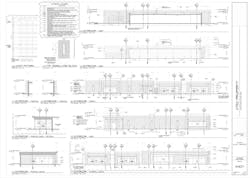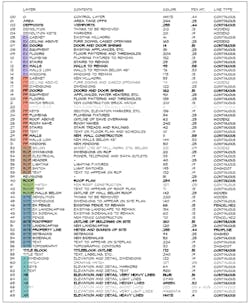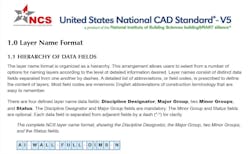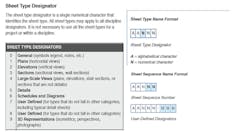Documenting Architecture
So you're sitting at your desk, you’ve got your project up on the monitor and you are in the zone and crushing it, but what does that even look like? The process of preparing drawings has evolved from “What do we need to do?” to “What can’t we do?” In today’s episode, we are going to talk about documenting architecture best practices in what is essentially creating the graphic instruction manual of constructing a building.
Topic 1: Purpose/ General info [04:40]
The main purpose of construction drawings, also called plans, blueprints, or working drawings), is to show what is to be built, while the specifications focus on the materials, installation techniques, and quality standards. However, the distinction is not clear cut. Most designers put basic construction information in the drawings and use the specs to elaborate on materials, techniques, and standards to be met. Others pack their drawings with written notes that cover many of the issues commonly contained in the specs. In some cases, you’ll find the same information in both places. If there is a conflict between the specs and drawing, the specs generally override the plans, at least legally.
We should probably spend a moment to discuss QA/QC and how the ever-evolving creation of digital drawings can actually present some challenges. I’m talking about drawing too much, duplication of information, unnecessary redundancies in the drawings, etc.
One of the important things about the documents you are creating is that they tell a story while providing instructions that are clear and easy to follow. The goal is to cover enough in the combined docs to allow the construction team to build the project, but this needs to be clear and rational. For example: if there is a spot in the building that is not represented it should be. As the contractor, if I cannot figure out how this area is intended to be constructed, then the documents need to show me … which seems pretty straightforward.
Topic 2: Arrangements [16:53 mark]
So let’s talk about where these consultant drawings should go within the entire drawing set. Let’s break down the set into sections:
• Cover Page
• Civil Consultant Drawings
• Landscape Architect Drawings
• Architectural Drawings
• Index and Schedule and Legends
• Life Safety and ADA Standards
• Plans
• Site Plans
• Grading Plans
• Floor Plans
• Roof Plans
• Reflected Ceiling Plans
• Exterior Elevations
• Building Sections
• Wall Sections
• Interior Elevations
• Enlarged Plans
• Details
• Schedules (if you are Andrew)
• Structural Consultant Drawings
• PEM … or MEP Consultant Drawings (or any other various order of Mechanical, Electrical, and Plumbing sheets)
• Specialty Drawings (any other consultant drawings]
• Kitchen equipment consultant
• Acoustical consultant
• Low voltage
There is a fairly large amount of difference between the residential and commercial document sets. While they contain similar elements, the complexity of those elements is where the differences reside. It isn’t all that uncommon for residential sets to not have anything other than architectural and structural. MEP is typically handled design-build but on very large, mostly high-budget residential projects, we would have this particular consultant on board. So typically commercial sets are larger, possibly denser, and often arranged in a different manner. Many firms arrange these sets in different ways and provide different information on different drawings. For example, a residential floor plan may contain all plan-related information, such as floor finish, wall types, ceiling finishes, and other items. On a commercial set, those plans may be all separate sheets of the plan. The commercial sets divide these up due to issues of scale and of readability. It would be possible to place all this information on one plan drawing for a commercial project, but typically due to the scale of the drawing and the amount of information presented, it would be almost impossible to read on a single drawing… so that information is spread across multiple plan drawings. There is a fine line that is at the discretion of the architect for what is enough information and what is too much on a single drawing. And this, of course, is an individual preference and varies within the profession. So our drawings sets begin to look different from one another. As Bob and I mention, we like to look at other architects/firms drawing documents to see how they do it. We look to see if there are ways we think are useful and we might be able to incorporate into our own ideas and preferences.
While the arrangement of drawing sets and individual sheets may vary among firms and architects, there is a general order in the sense that the projects are typically arranged from the big picture to small details. Meaning as you move deeper into a set of drawings, the amount of detail will increase. This ‘standard’ is at least unified by all in the profession. The idea that you start with the overall view of the project and work your way into the smaller details and intricacies of the project appears to be ingrained in our professional brain as the proper way to organize a set of project drawings. I am not certain when this concept came about exactly, but I would think it involved the loss of skilled craftsman, the increased complexity of projects and probably some other labor or legal issues.
Topic 3: Standards [38:53 mark]
Is there a particular scale associated with each of these types of drawings? There is a difference – albeit not much of one – between residential drawings and commercial drawings. Residential drawings tend to have larger-scale plans and interior elevations as their standard: ¼” plans and 3/8” interior elevations. The only reason I can think as to why this happens is the size of the project and trying to minimize the number of match lines you might include in a drawing.
I would also feel somewhat comfortable in saying that residential drawing sets make use of ½” = 1’-0” scale far more often than commercial sets.
There really is an economy of scale that motivates how the project information is conveyed and depicted within the sets. For example:
• Partition Types
• Door Schedules
• Finish Schedules
All of these sorts of “organizational” drawings exist in different capacities between commercial and residential drawing sets.
What about the USNCS (United States National CAD Standard)?
These standards were developed starting around 1999-2000. They are a set of guidelines that attempt to standardize multiple aspects of the CAD (and now BIM) work in the A/E profession. The NCS includes guidelines for sheet layouts, sheet ordering, layer naming, sheet identification, and many other aspects. This standard was developed by several organizations along with the US General Services Administration (GSA). It is now on the 6th iteration and includes some standards for BIM usage. The main goal here is just to make things easier across the lifespan of the documents used in our industry. While Bob seems to be personally opposed to this idea from an aesthetic point of view, I, on the other hand, see the rationale and adopted most of these standards in my practice when I was using CAD (so long ago). As a new young firm owner, the standardization of this was appealing along with the detailed and thoroughness of the system. (It definitely hit home with my OCPD side) Also, I had a couple of new projects that required my firm to use this standard, so adoption was required. But even now many of them still remain in my BIM set up and construction document standards. I still use the sheet organization, the sheet identification, and the overall set organization plus a few other small items. I am not a die-hard follower to this set of guidelines and would not state that this is a perfect system, but it is very thorough and fairly easy to follow.
Topic 4: Purpose / Evolution [ 58:31 mark]
So where is all of this headed in the future? What does the future of architecture documentation look like? What are we attempting to do with our construction docs? It seems that the near future architects will no longer create physical drawing sets. Currently, we have three-dimensional models that we build to then transfer to our two-dimensional drawings sets on “paper”. Bob and I both agree that in the future, we may not have this transition from three dimensional to two dimensional. This is currently happening ins some instances now where the construction team no longer uses the ‘paper’ drawings but gets the three dimensional model and utilization of that for their construction processes. We do agree that as of now this is not a 100% ‘paper’ free process. The breakdown begins to occur when the process moves into the field for the actual installation. From our experiences, we still see the ‘paper’ drawings are still required for those groups within the construction team that install the work. How does this process become ‘paper’ free? Will this involve some type of AR or VR in the future that allows the installation team to virtually see what they are required to construct? That seems to be a logical conclusion to draw from the current situation in the industry, but as we all know, the future can change and is hard to predict. So only time will tell when and how architecture becomes a fully three-dimensional practice, but it will certainly happen.
These hypothetical questions are definitely Library of Congress level recordings – and I think that they are getting harder and harder to record and keep them A) appropriate for a family-friendly podcast where all ages of listener are possible, and/or B) able to start and finish in a reasonable amount of time. It’s not as easy as you might think … [ 63:45 mark]
"If you had to be haunted by a presumably friendly ghost for the rest of your life, but could choose which dead person the ghost would be, who would you choose?"
This turned out to be a lot harder than I had originally imagined. Do you choose some historical figures? Do you choose someone who you think will keep you engaged and possibly entertained? What about a ghost of the opposite gender … they’re ALWAYS there!!
The process of documenting architecture projects while somewhat standard across the industry still has some varying degrees of differences within our profession. There is definitely a split between residential and commercial documentation mainly due to levels of complexity, code, and regulations. Also, there is an increasing rift between those that see the project construction documents as a work of art and those who view them simply as a piece of production. As Bob and I tend to lean decidedly in the art camp, we have strong opinions about documentation and we tend to press those ideals on our colleagues. We think this is an important part of the current process of the profession and can easily represent a certain level of care and attention from the architect (and his team) to the clients and constructors of our projects. Please be sure to drop us a line about how your construction document process falls within our discussion. As you can see from this lengthy episode, Bob and I take great interest in this subject and would really enjoy learning about others’ methods for documenting architecture.
Cheers and take it easy everyone,


